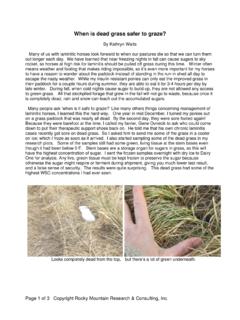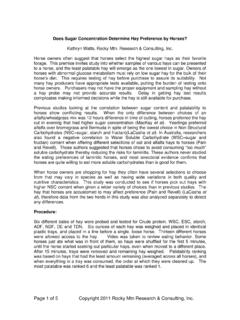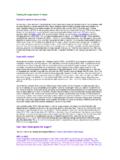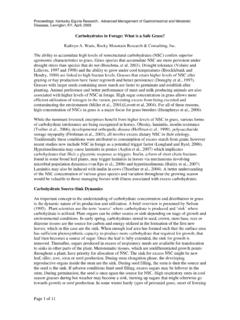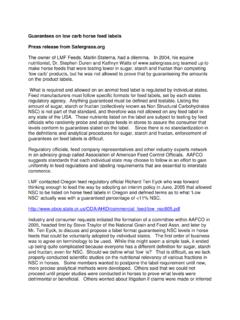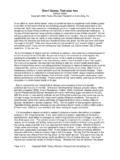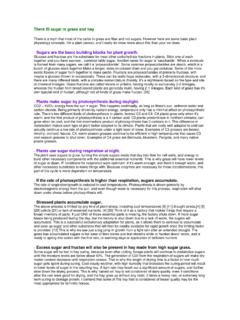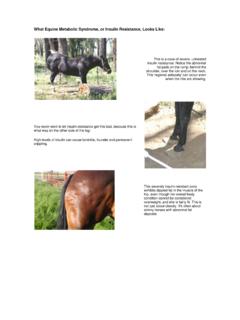Transcription of What kind of forage is safer?
1 what kind of forage is safer ? Bottom line: You cannot plant a grass that is low in sugar all the time that will survive continuous grazing of confined animals. You must learn to manage your horse's grazing and learn how to grow healthy, unstressed grass. All the of grasses that survive grazing of confined animals can get too high in sugar under certain conditions. The following discussion will help you learn what those conditions are, so that you can restrict or eliminate grazing when they happen. There are many factors that affect the NSC levels in grass, and these factors may very well overcome any intrinsic levels of any one specie of grass. The genetic potential for NSC content of any particular kind of grass cannot be taken out of context from the conditions that created it. Conditions that may be stressful for one type of grass may be just right for another type. Factors that interact to determine the NSC content of grass include: genetic potential, temperature, water, light intensity, time of day, stage of growth, nutrient status of the grass, part of the plant, and in hay, the conditions occurring during hay curing.
2 These factors may be accumulative, or may cancel each other out. In this section we will look at genetic potential, but lets keep it in proper context. It s NOT the most important factor. All varieties of grass hay should be tested for NSC for carbohydrate intolerant horses . Type of plant : In general, C3 cool season grasses like orchard, timothy, brome, crested wheatgrass are higher in NSC than C4 warm season grasses like Bermuda, summer prairie grasses, and other grasses of tropical origin. This is because C4 grasses store starch instead of fructan. Starch forms in specialized organelles in the grass. When those organs are full, starch production stops, so starch production is self-limiting. In C3 grasses, fructan is stored in various places all over the plants and can continue as long as conditions are conducive to formation of sugar, while growth is limited. Varietal differences: Even grass of the same genus and species, but of a different variety, may differ in NSC content, even under the same conditions.
3 So one kind of Kentucky bluegrass (timothy, orchard, etc.) may plant metabolismbe significantly different from another variety of Kentucky bluegrass. The USDA forage and Rangeland Research Lab in Logan, UT , has conducted a variety trial with plots duplicated at my facility. We have collected samples 8 times throughout the 2004 and 2005 growing season. They are being analyzed for sugar, starch and fructan levels. Hopefully the data will be ready sometime in 2006. Preliminary data is showing native, unimproved species to be relatively lower than varieties of grass improved for 'higher nutritional content' when sampled under the same conditions. The only varieties I have tested under my 'worst case environmental conditions' that are consistently safe for an insulin resistant, chronically laminitic horse are native species. Unfortunately, these low sugar grasses are going to be extremely difficult to maintain under intensive grazing.
4 They will have lower yield potential, and will die out quickly if overgrazed. Those wishing to grow low sugar hay may have to be content with one cutting per year, and half the production of high NSC species. Please do not think that just planting native grass will solve your problems. Information on the best management practices necessary to maintain native species under intensive grazing do not exist, and may not even be possible. A system of rotational grazing will be imperative. Native grass seed is expensive, and establishing a native grass pasture may require a full year for establishment before it can be grazed at all. If you want to experiment, start with a small section of pasture to see which species will live under your environmental conditions and management practices. Species like orchard, timothy, fescue, Kentucky bluegrass and perennial ryegrass have the highest genetic potential for NSC. These grasses are generally consider 'best' due to their relatively higher nutrient content, and palatability.
5 They are prized by horse farms raising 16 hand 2 YO TB's ready for racing, and cattle producers. I have frequently found these to be 25+% under worst case environmental conditions. This is about twice the NSC that an insulin resistant horse should get. No wonder our horses like them! Perennial ryegrass is usually the highest in studies comparing NSC content of grasses in studies done all around the world. I'm calling it the Quintessential Founder Fodder. If your climate is cloudy, you may still be able to find batches of hay of these species that are appropriate for a carbohydrate intolerant horse. Remember: environmental conditions are more important than genetic potential! Some TB's are slow and lazy; some orchard grass may be low in sugar. Don't buy a racehorse without a watching him run, don't buy hay for an lamintic horse without testing for NSC. Grain Hays: In general, avoid hays made from grain crops like oats, wheat, barley, rye or triticale.
6 These have been selected for high starch content and when cut in flower stage these are full of sugar held ready for use by the developing seed. I have samples of oat hay grown in Colorado, and 3 way forage (wheat, oats, rye) grown in California that were over 30% NSC, over twice average. According to the database at Dairy One, oat hay averages 22% NSC, with a normal range of 15-29, while other grass hays average with a normal range of 9-18. You may get lucky and find some in the low range, but make sure you test before feeding grain hays to a carb intolerant equine. Legumes-alfalfa and clover: There is a lot of conflicting data regarding carb levels. They will test high in NFC, but nearly half of that may be pectin, which is a safe form of carbohydrate. The NSC, or sugar and starch, of legumes is variable with stage of growth and environmental conditions, but generally lower in NSC than grass growing next to it. Neither alfalfa nor clover has appreciable levels of fructan.
7 There is anecdotal evidence of horses foundering on straight alfalfa, but this may well be from excess protein, or other as yet undetermined factors that may include phytoestrogens or fungal toxins produced by pathogens infesting the legumes. Clover may have much higher levels of phytoestrogens under certain growing conditions. I am not aware of any research on the effect of phytoestrogens on horses , but some of the effects documented in sheep, including infertility and permanent changes in sexual organs, cause me concern. (Adams, full text) I have spoken to vets who felt that clover was involved in worsening of symptoms in equines with metabolic dysfunction, so we have to at least consider it a risk factor for horses prone to laminitis of metabolic origin. It should be important to note that laminitis experts in the UK do feel that alfalfa (they call it lucerne) is an appropriate ingredient in feeds tailor made for laminitic equines.
8 But also note that the cloudy climate is such that the alfalfa grown there is very different from the high quality alfalfa such as grown in the US. Because really high quality alfalfa in the SW of the US can average up to 25% protein, which can be utilized as energy when in such excess, and up to 20% NSC, this type of forage is totally inappropriate for any horse prone to laminitis, unless fed in small quantities. A lot of horses seem to tolerate straight alfalfa diets fairly well, while some horses cannot tolerate any alfalfa. Perhaps a horses particular metabolic make up will determine it s sensitivity? My severely insulin resistant horses are doing very well with up to 20% of their diet as mature, stemmy, alfalfa, so I m not too afraid of a little bit. If the protein of the available grass hay is less than about 8-9%, your horse might tolerate a small amount of mature, stemmy alfalfa, with a lot of purple flowers. Avoid the premium, dairy quality stuff, which unfortunately is far more common.
9 Be careful, so slow, be observant, and keep it at a minimum to provide adequate, but not excessive, protein. When discussing this issue with a forage researcher, he came up with a very logical reason why alfalfa/grass mix hays may be creating more problems for us than straight grass hays. When deciding when to cut a mixed field for hay, the growers generally focus on the stage of the alfalfa. When alfalfa is 10% bloom, the grass in the same field is usually in late boot stage, or just in head emergence stage. This stage of growth is very high in sugar/fructan. If the hay grower waits until the grass is mature and sugar is lower, the alfalfa will often be over mature and losing leaves. Frankly, this latter scenario may produce very appropriate hay, and I have fed this kind of hay successfully-it was primarily brome with 10% alfalfa but the first and only cutting was done in late August. Weekend, hobby farmers are a good source for lower quality hay in my area.
10 As the hay grower is usually not very proud of it, it can be purchased at bargain prices. Commercial hay farmers consider this kind of hay an embarrassment. My horses love alfalfa stems, and it tested very low in NSC. Be sure and check mineral ratios and balance with appropriate mineral supplements. When choosing alfalfa pellets, sun dried (slow dried) will be lower in carbs than dehydrated (fast dried).
